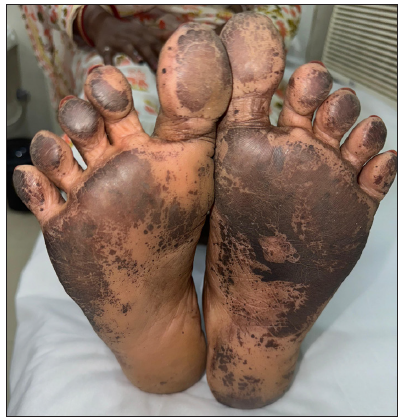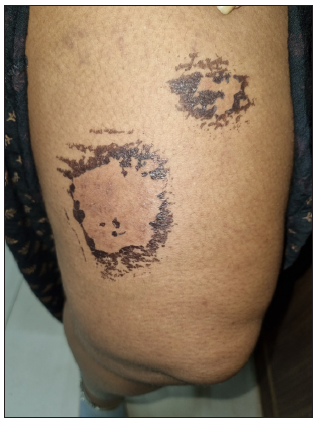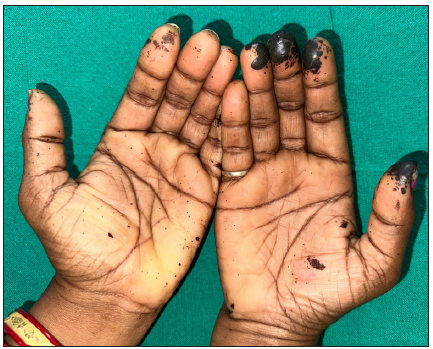Translate this page into:
Irritant contact dermatitis to electoral ink: A series of 12 patients
Corresponding author: Dr. Dillip Kumar Behera, Department of Dermatology, Kalinga Institute of Medical Sciences, KIIT (deemed-to-be) University, Patia, Bhubaneshwar, India. dillip.behera48@gmail.com
-
Received: ,
Accepted: ,
How to cite this article: Begum F, Raj C, Behera D, Behera DK. Irritant contact dermatitis to electoral ink: A series of 12 patients. Indian J Dermatol Venereol Leprol. doi: 10.25259/IJDVL_982_2024
Dear Editor,
The indelible ink currently used in election polls was created by the Council of Scientific and Industrial Research-National Physical Laboratory (CSIR-NPL), a research institute of CSIR under the Ministry of Science and Technology, Government of India, and manufactured by Mysore Paints and Varnish Ltd.1 Although the precise composition of the ink is kept confidential, it is believed that silver nitrate is a key component.
Silver nitrate, when exposed to ultraviolet light, leaves a permanent mark that cannot be washed off. This ink is commonly applied on the left index finger in a linear fashion, covering both the cuticle and the nail plate. The part applied on the cuticle cannot be erased and is only removed when the external skin cells are replaced. The part applied on the nail plate comes off only when the nail grows beyond the distal nail fold.
Due to its interaction with the skin’s protein component, silver nitrate is difficult to remove and can stay on for two to three weeks.2 We are reporting 12 cases of irritant contact dermatitis that developed after the application of ink.
We encountered 12 patients in our dermatology outpatients with ages ranging from 22 to 57 years, including 5 men and 7 women, all exhibiting symptoms of irritant contact dermatitis within seven days after the conclusion of elections in Eastern India. Most of them were working as polling officers, while five patients were general voters. Three of them developed lesions in the form of erythema, blistering, and erosion on the index finger. One voter exhibited erosions simulating that of a first-degree burn on the left middle finger. Another voter displayed partial burn-like features on the dorsum of feet due to spillage of ink on the floor as a consequence of manhandling by some miscreants [Figure 1]. During this episode, one woman polling officer developed irritant dermatitis on the right thigh and ventral aspect of the right forearm due to accidental spillage of ink [Figure 2]. Some polling officers developed painful blisters on the fingertips from ink exposure during application on the voter [Figure 3].

- Diffuse staining of both soles by indelible ink.

- Post-inflammatory hyperpigmentation with mild scaling on the right thigh on the 7th day of contact.

- Erythema, blistering, and tenderness on both palms (right > left), seen on the 2nd day of ink spillage.
Few patients reported the very next day of voting, while others reported between 5 and 7 days after polling. Most of them developed erythema, blistering, erosion, itching, or a burning sensation. A severe form of irritant contact dermatitis causing necrosis of the epidermis was seen as well. Most of the lesions were associated with mild pain and tenderness. A detailed summary of our cases is given in Table 1.
| Sl. No | Age/sex | Role in voting | Areas involved | Types of lesions |
|---|---|---|---|---|
| 1 | 57/F | Voter | Left index finger | Erythema and erosion |
| 2 | 38/M | Voter | Left ring and middle finger | Erythema, blister, and erosion |
| 3 | 32/F | Polling officer | Right-hand fingertips | Painful blisters |
| 4 | 24/F | Polling officer | Tip of right index finger | Painful blisters and erosions |
| 5 | 38/M | Polling officer | Right thumb and index finger | Blisters and erythema |
| 6 | 29/M | Polling officer | Both feet | Mild erythema, tenderness and burning sensation |
| 7 | 44/F | Voter | Dorsum of both feet | Small painful erosions and blisters |
| 8 | 46/F | Polling officer | Fingertips of both hand and palms | Erythema, induration, and blisters |
| 9 | 50/M | Voter | Left index finger | Erosion |
| 10 | 26/M | Voter | Dorsum of right hand and forearm | Erosion and erythema |
| 11 | 35/F | Polling officer | Right thumb, index, and middle finger | Erythema and induration |
| 12 | 22/F | Polling officer | Right thigh and forearm | Post-inflammatory hyperpigmentation and mild scaling |
All these patients were treated symptomatically with oral antibiotics, antihistamines, topical corticosteroids, and emollients. Patients were followed up after ten days and by then all the lesions had healed with post-inflammatory hyperpigmentation or hypopigmentation.
The indelible ink generally persists on the skin for 72 to 96 hours and lasts for about two to four weeks on the cuticle and fingernail. This ink contains solvents like alcohol, which dries up quickly, leaving the stain non-erasable.
The indelible ink used for voting contains about 10%–18% silver nitrate, along with other chemicals, dyes, and aromatic materials.3 Mishra et al. suggested that prolonged exposure to older ink, frequent use, or higher concentration at the application site could potentially cause varying degrees of harm, despite the ink being considered safe for the skin at its current concentration.4
In addition to its use in voting, the indelible marker has been used in a study to measure the rate of nail growth.5 It has also been authorised by the Indian Election Commission for stamping purposes for individuals in home quarantine during COVID-19 waves.6 A recent study by Bisoyi et al. documented four cases of contact dermatitis due to the COVID-19 quarantine stamp.7
Similarly, Mishra et al. previously reported an incident in which voters’ indelible ink caused partial thickness burns on their fingertips.4 Upon further investigation, the polling officers admitted that they had not been informed about possible adverse reactions.
There is not much literature on the irritant effects of indelible ink used in the electoral process. Only some cases have been reported on its use in quarantine stamping. This could be a reason for not using protective gloves or taking extra measures to prevent the dermatitis.
Although the electoral ink has been a part of general elections in India since 1962, awareness of possible adverse effects is minimal. We believe that such cases are more prevalent but are underreported, probably because of a lack of awareness. Therefore, more awareness should be created and protective measures such as using gloves should be promoted.
Declaration of patient consent
The authors certify that they have obtained all appropriate patient consent.
Financial support and sponsorship
Nil.
Conflicts of interest
There are no conflicts of interest.
Use of artificial intelligence (AI)-assisted technology for manuscript preparation
The authors confirm that there was no use of artificial intelligence (AI)-assisted technology for assisting in the writing or editing of the manuscript and no images were manipulated using AI.
References
- Gupta AK. Lok Sabha elections 2024: Sole supplier of indelible ink says 70% production complete. Hindustan Times. 2024-03-06. Sect: India news. Available from: https://www.hindustantimes.com/india-news/lok-sabha-elections-2024-sole-supplier-of-indelible-ink-says-70-production-complete-101709704290159.html. [Accessed July 01, 2024].
- Bennur S. Inking its election imprint. The Hindu. 2014-3-6. Sect: Karnataka. Available from: https://www.thehindu.com/news/national/karnataka/inking-its-election-imprint/article5755944.ece. Accessed July 01, 2024.
- Voter’s ink: Made in Mysore, marked across India. News 18. Available from: http://www.ibnlive.in.com/news/voters-ink-made-in-mysoremarked-across-india/87219-37.html. Accessed July 01, 2024.
- Indelible voters’ ink causing partial thickness burn over the fingers. Indian J Plast Surg. 2014;47:472-73.
- [CrossRef] [PubMed] [Google Scholar]
- A pilot study: Nailing Indian elections with the indelible ink mark. Indian J Dermatol. 2015;60:562-65.
- [CrossRef] [PubMed] [PubMed Central] [Google Scholar]
- Bakshi G. Election Commission allows use of indelible ink to stamp home quarantine people. Jagran Josh. Sect: Current affairs. Available from: https://www.jagranjosh.com/current-affairs/election-commission-allows-use-of-indelible-ink-to-stamp-home-quarantine-people-1585193939-1. Accessed July 01, 2024.
- COVID-19 quarantine stamp contact dermatitis: A report of four cases. Indian Dermatol Online J. 2024;15:689-91.
- [CrossRef] [PubMed] [PubMed Central] [Google Scholar]





